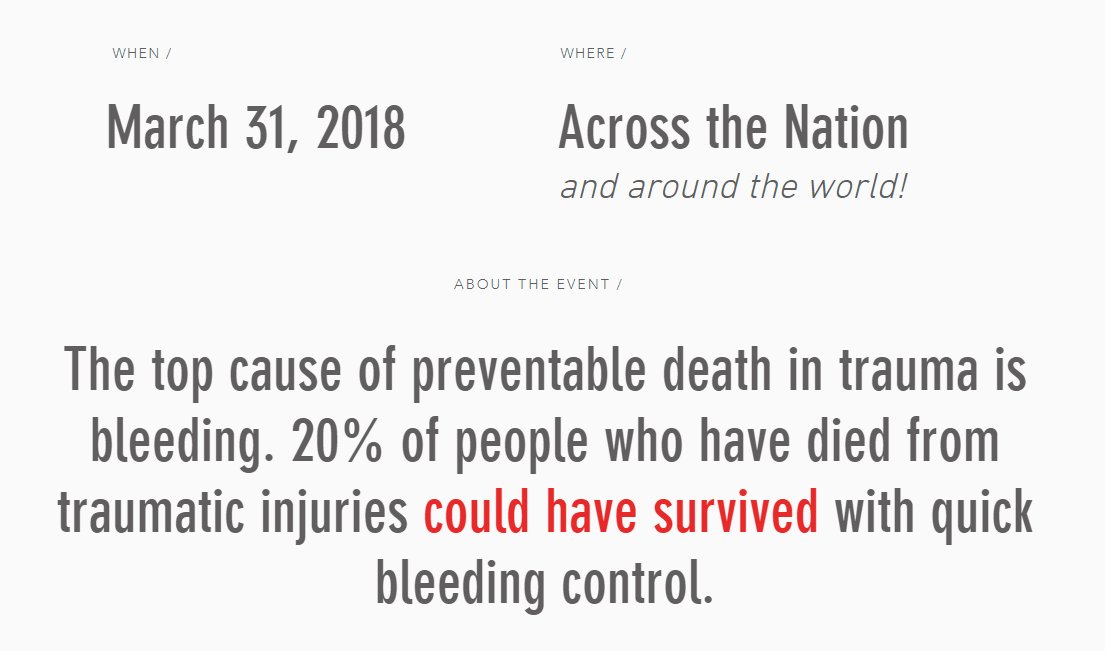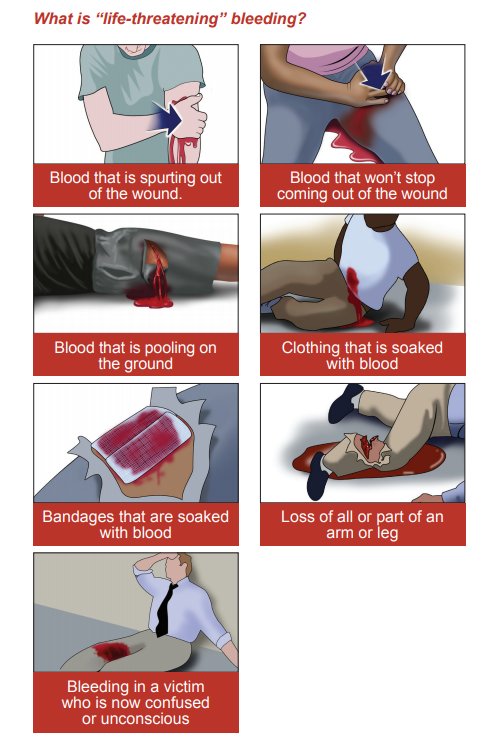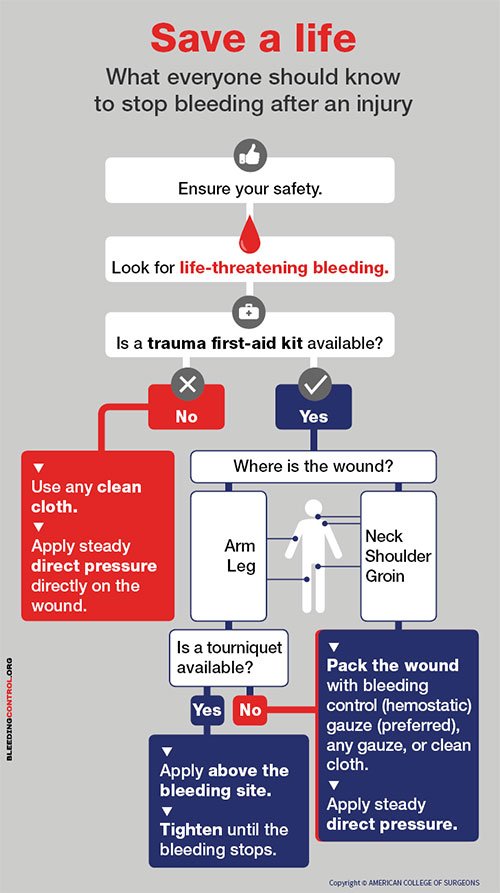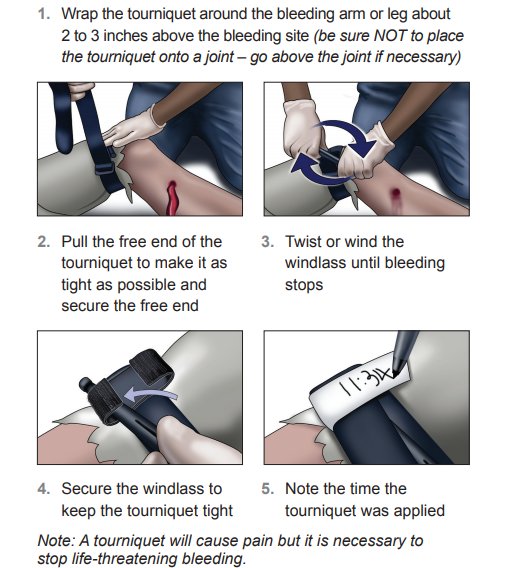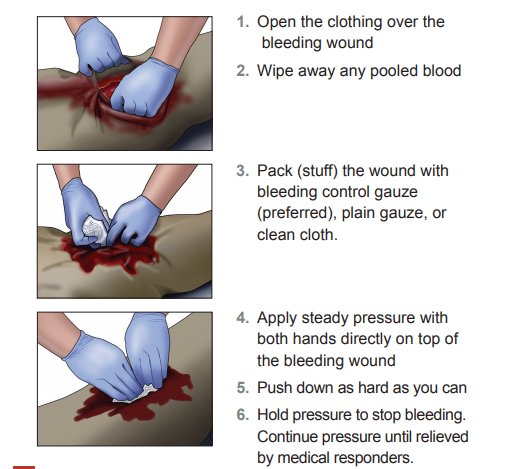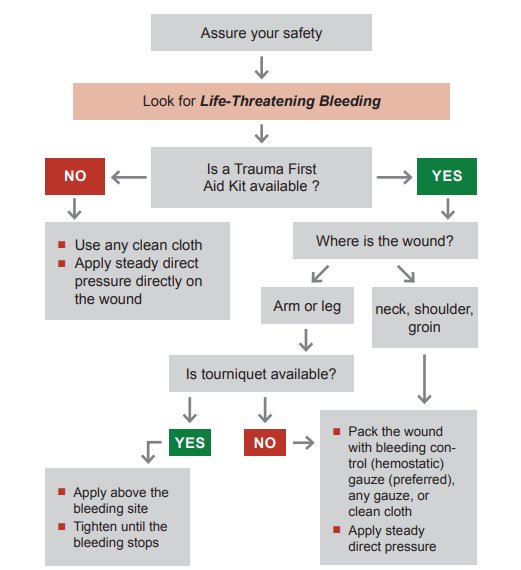THREAD: This weekend marks National Stop the Bleed Day, sparked when an Army SOF medic decided to see how many people could be taught basic bleeding control in one day.
I'm going to try something new: teaching a BCon class via Twitter. #NSTBD18
I'm going to try something new: teaching a BCon class via Twitter. #NSTBD18
My credentials are that I'm a nationally registered EMT, which you can check on the registry here: https://www.nremt.org/rwd/public/dashboard/check-cert-status
And I'm certified by the American College of Surgeons' Committee on Trauma to teach basic bleeding control.
And I'm certified by the American College of Surgeons' Committee on Trauma to teach basic bleeding control.
Stop the Bleed is a government initiative that was created in the wake of the Sandy Hook shooting, to enhance public resilience to mass casualty events.
But you're more likely to need to use bleeding control at a car accident or tripping and hitting your head than at a shooting
But you're more likely to need to use bleeding control at a car accident or tripping and hitting your head than at a shooting
Rick Santorum recently created waves when he said students should learn CPR to deal with shootings.
CPR is not the right skill for a trauma scenario. Bleeding control is. So let's learn about it.
#NSTBD18
CPR is not the right skill for a trauma scenario. Bleeding control is. So let's learn about it.
#NSTBD18
Bleeding Control is an essential skill for a trauma situation. In fact, learning to control bleeding could save more lives than CPR can.
Of the 147,000 trauma deaths in 2014, 30,000 might have survived with appropriate care, primarily control of bleeding
#NSTBD18
Of the 147,000 trauma deaths in 2014, 30,000 might have survived with appropriate care, primarily control of bleeding
#NSTBD18
Why is bleeding control important? The body has approx 4-5 liters of blood. Blood supplies oxygen to your cells and tissues.
As you lose blood volume, you start down the road of exsanguination - fatal blood loss.
You can die of blood loss in as little as 2-3 minutes
#NSTBD18
As you lose blood volume, you start down the road of exsanguination - fatal blood loss.
You can die of blood loss in as little as 2-3 minutes
#NSTBD18
What is life threatening bleeding? If an injury cuts an artery, this is life threatening. Spurting, bright red blood is a key sign.
Blood pooling, soaked cloathing, a partial or full amputation, an unconscious victim -- all are signs of a life threat.
Blood pooling, soaked cloathing, a partial or full amputation, an unconscious victim -- all are signs of a life threat.
Let's walk through the steps of civilian bystander bleeding control.
First, ensure your own safety. Is it safe to step in?
Second, follow the ABCs:
A: Alert 9-1-1
B: Bleeding: Find/expose the bleeding injury
C: Compress: apply pressure to stop the bleeding.
#NSTBD18
First, ensure your own safety. Is it safe to step in?
Second, follow the ABCs:
A: Alert 9-1-1
B: Bleeding: Find/expose the bleeding injury
C: Compress: apply pressure to stop the bleeding.
#NSTBD18
What are we compressing? We're putting pressure on blood vessels to stop bleeding.
You can do this in three ways: applying direct pressure; or, if you have a medical kit, using a tourniquet or wound packing with gauze
You can do this in three ways: applying direct pressure; or, if you have a medical kit, using a tourniquet or wound packing with gauze
Scene safety: This is your first priority. The situation becomes significantly worse if you become a casualty.
If your safety is threatened, attempt to remove yourself (and victim if possible) from danger
If you have gloves, don them.
#NSTBD18
If your safety is threatened, attempt to remove yourself (and victim if possible) from danger
If you have gloves, don them.
#NSTBD18
A: Alert 9-1-1 either by calling them yourself or having someone else call
When you're doing bleeding control, you're buying time for EMTs, paramedics and doctors to solve the problem.
When you're doing bleeding control, you're buying time for EMTs, paramedics and doctors to solve the problem.
B: Bleeding -- Find and expose the source of the bleeding so you can assess it
Remember, you're looking for spurting blood, pooled blood, soaked clothing, loss of consciousness.
Remember, you're looking for spurting blood, pooled blood, soaked clothing, loss of consciousness.
C: Compression -- Bleeding control is fundamentally about putting pressure on a blood vessel.
Without a trauma first aid kit, the best practice is called 'Direct Pressure' #NSTBD18
Without a trauma first aid kit, the best practice is called 'Direct Pressure' #NSTBD18
Direct pressure is accomplished by taking a clean cloth:
1. Covering the wound and pressing down
2. If the wound is large and deep, you want to stuff the cloth into the wound.
Remember, the artery is deep inside the body, under flesh and skin. PUT AS MUCH PRESSURE AS POSSIBLE
1. Covering the wound and pressing down
2. If the wound is large and deep, you want to stuff the cloth into the wound.
Remember, the artery is deep inside the body, under flesh and skin. PUT AS MUCH PRESSURE AS POSSIBLE
If you have a trauma kit, and the life threatening bleeding is on an extremity (arms or legs), use a tourniquet.
I carry a CAT (combat application tourniquet) in my backpack.
Here's a video on how to use one:
I carry a CAT (combat application tourniquet) in my backpack.
Here's a video on how to use one:
Here's the basics of tourniquet usage:
1. Tighten the strap of a tourniquet above the wound.
2. Twist the rod until the bleeding stops
3. Secure the windlass
4. Note when the tourniquet was applied
#NSTBD18
1. Tighten the strap of a tourniquet above the wound.
2. Twist the rod until the bleeding stops
3. Secure the windlass
4. Note when the tourniquet was applied
#NSTBD18
If you don't have a tourniquet, or the bleeding is in the neck, shoulder, armpit or groin, we're doing to do what is called wound packing.
Stuff the wound with bleeding control gauze (aka hemostatic gauze) or clean cloth. The apply downward pressure with both hands.
#NSTBD18
Stuff the wound with bleeding control gauze (aka hemostatic gauze) or clean cloth. The apply downward pressure with both hands.
#NSTBD18
As a summary, let's look at this flowchart: How do you stop bleeding in each of these scenarios?
#NSTBD18
#NSTBD18
All of images/video I've used in this impromptu bleeding control tweetstorm are found on http://BleedingControl.org .
Reading these tweets is just a start. But I hope it has been interesting to you -- and maybe even a little helpful. #NSTBD18
Reading these tweets is just a start. But I hope it has been interesting to you -- and maybe even a little helpful. #NSTBD18
Reading my ramblings on Twitter is not going to be sufficient. Nothing replicates hands on training. #NSTBD18
Find out where you can get a FREE bleeding control class here: https://www.bleedingcontrol.org/march31
// END
Find out where you can get a FREE bleeding control class here: https://www.bleedingcontrol.org/march31
// END

 Read on Twitter
Read on Twitter